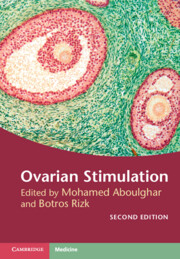Book contents
- Ovarian Stimulation
- Ovarian Stimulation
- Copyright page
- Dedication
- Contents
- Contributors
- About the Editors
- Foreword
- Preface to the first edition
- Preface to the second edition
- Section 1 Mild Forms of Ovarian Stimulation
- Chapter 1 Oral Agents for Ovarian Stimulation
- Chapter 2 Ovulation Induction for Anovulatory Patients
- Chapter 3 Ovarian Hyperstimulation in Combination with Intrauterine Insemination
- Chapter 4 Mild Approaches in Ovarian Stimulation
- Chapter 5 The Case against Mild Stimulation Protocols
- Section 2 Ovarian Hyperstimulation for IVF
- Section 3 Difficulties and Complications of Ovarian Stimulation and Implantation
- Section 4 Non-conventional Forms Used during Ovarian Stimulation
- Section 5 Alternatives to Ovarian Hyperstimulation and Delayed Transfer
- Section 6 Procedures before, during, and after Ovarian Stimulation
- Index
- References
Chapter 2 - Ovulation Induction for Anovulatory Patients
from Section 1 - Mild Forms of Ovarian Stimulation
Published online by Cambridge University Press: 14 April 2022
- Ovarian Stimulation
- Ovarian Stimulation
- Copyright page
- Dedication
- Contents
- Contributors
- About the Editors
- Foreword
- Preface to the first edition
- Preface to the second edition
- Section 1 Mild Forms of Ovarian Stimulation
- Chapter 1 Oral Agents for Ovarian Stimulation
- Chapter 2 Ovulation Induction for Anovulatory Patients
- Chapter 3 Ovarian Hyperstimulation in Combination with Intrauterine Insemination
- Chapter 4 Mild Approaches in Ovarian Stimulation
- Chapter 5 The Case against Mild Stimulation Protocols
- Section 2 Ovarian Hyperstimulation for IVF
- Section 3 Difficulties and Complications of Ovarian Stimulation and Implantation
- Section 4 Non-conventional Forms Used during Ovarian Stimulation
- Section 5 Alternatives to Ovarian Hyperstimulation and Delayed Transfer
- Section 6 Procedures before, during, and after Ovarian Stimulation
- Index
- References
Summary
The lack of ovulatory cycles may be considered as a major problem for women seeking pregnancy. This is reflected by the fact that about 20 percent of couples visiting a fertility clinic with an unfulfilled wish to conceive present with anovulation [1]. Clinical manifestation of anovulation is oligomenorrhea (intermenstrual period > 35 days) or amenorrhea (intermenstrual period > 6 months). Although ovulation may occur in oligomenorrhea, the longer the time period between menstruations the smaller the chance of that cycle being ovulatory. Classification of anovulatory patients may be performed using the criteria of the World Health Organization (WHO) as determined by Rowe et al.
- Type
- Chapter
- Information
- Ovarian Stimulation , pp. 15 - 28Publisher: Cambridge University PressPrint publication year: 2022



